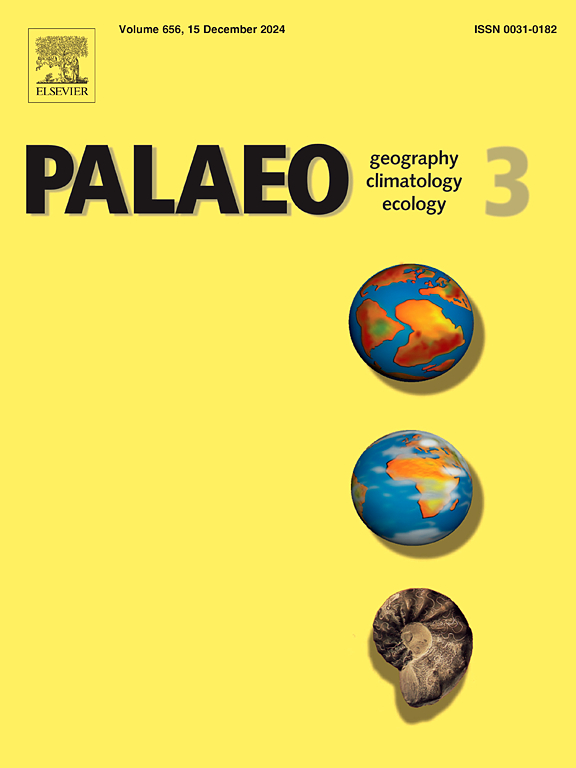Testing for presence of alternative photosynthetic pathways in plants during the Mississippian
IF 2.6
2区 地球科学
Q2 GEOGRAPHY, PHYSICAL
Palaeogeography, Palaeoclimatology, Palaeoecology
Pub Date : 2025-02-17
DOI:10.1016/j.palaeo.2025.112819
引用次数: 0
Abstract
The evolutionary emergence of the CAM (Crassulacean Acid Metabolism) photosynthetic pathway is unknown, but some studies have speculated it may have emerged during the Devonian-Carboniferous when vascular plants first proliferated in terrestrial environments. Specifically, some Carboniferous arborescent lycopsids (e.g., Lepidodendropsis) have morphological features similar to modern CAM plants. In this study, we systematically examine the carbon isotope compositions of an assemblage of Tournaisian (Mississippian) Lepidodendropsis for evidence of alternative photosynthetic pathways. Previous work suggests that the CAM pathway can produce δ13C signatures that are distinct from the C3 pathway due to differences in isotopic discrimination during carbon fixation. Analyses were performed on Lepidodendropsis sp. and coeval presumed C3 plants (i.e. Genselia and Rhodeopteridium sp.) from the same fossil plant assemblage within the Price Formation of southwestern Virginia, U.S.A. The investigated plant fossils were limited to single assemblages from four localities within the Price Formation in an attempt to control differences in environmental conditions (differences in CO2, local climate, etc.) and diagenetic history that could affect the carbon isotope compositions of the fossil plants. The full dataset yielded a mean δ13C of −22.5 ± 0.7 ‰ for the CAM/CAM-like plants (n = 35) and a mean δ13C of −22.7 ± 0.7 ‰ for the suggested C3 plants (n = 36). The lack of isotopic difference between the coeval C3 plants and that of Lepidodendropsis does not preclude the possibility that these plants were using a CAM pathway and leaves open three possibilities for the photosynthetic pathway that Lepidodendropsis employed: 1) the C3 metabolism 2) aquatic CAM or 3) facultative CAM. More broadly, our study provides a more systematic framework for future studies to test for the presence of a CAM or CAM-like pathway in ancient plants.
求助全文
约1分钟内获得全文
求助全文
来源期刊
CiteScore
5.90
自引率
10.00%
发文量
398
审稿时长
3.8 months
期刊介绍:
Palaeogeography, Palaeoclimatology, Palaeoecology is an international medium for the publication of high quality and multidisciplinary, original studies and comprehensive reviews in the field of palaeo-environmental geology. The journal aims at bringing together data with global implications from research in the many different disciplines involved in palaeo-environmental investigations.
By cutting across the boundaries of established sciences, it provides an interdisciplinary forum where issues of general interest can be discussed.

 求助内容:
求助内容: 应助结果提醒方式:
应助结果提醒方式:


